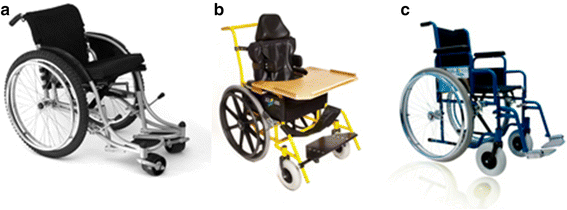The impact of the World Health Organization 8-steps in wheelchair service provision in wheelchair users in a less resourced setting: a cohort study in Indonesia
- PMID: 26801984
- PMCID: PMC4722611
- DOI: 10.1186/s12913-016-1268-y
The impact of the World Health Organization 8-steps in wheelchair service provision in wheelchair users in a less resourced setting: a cohort study in Indonesia
Abstract
Background: For people who have a mobility impairment, access to an appropriate wheelchair is an important step towards social inclusion and participation. The World Health Organization Guidelines for the Provision of Manual Wheelchairs in Less Resourced Settings emphasize the eight critical steps for appropriate wheelchair services, which include: referral, assessment, prescription, funding and ordering, product preparation,fitting and adjusting, user training, and follow-up and maintenance/repairs. The purpose of this study was to investigate how the provision of wheelchairs according to the World Health Organization's service provision process by United Cerebral Palsy Wheels for Humanity in Indonesia affects wheelchair recipients compared to wait-listed controls.
Methods: This study used a convenience sample (N = 344) of Children, Children with proxies, Adults, and Adults with proxies who were on a waiting list to receive a wheelchair as well as those who received one. Interviews were conducted at baseline and a 6 month follow-up to collect the following data: Demographics and wheelchair use questions, the World Health Organization Quality of Life-BREF, Functional Mobility Assessment, Craig Handicap Assessment Recording Technique Short Form. The Wheelchair Assessment Checklist and Wheelchair Skills Test Questionnaire were administered at follow up only.
Results: 167 participants were on the waiting list and 142 received a wheelchair. Physical health domain in the World Health Organization Quality of Life-BREF improved significantly for women who received a wheelchair (p = 0.044) and environmental health improved significantly for women and men who received a wheelchair as compared to those on the waiting list (p < 0.017). Satisfaction with the mobility device improved significantly for Adults with proxies and Children with proxies as compared to the waiting list (p < 0.022). Only 11 % of Adults who received a wheelchair reported being able to perform a "wheelie". The condition of Roughrider wheelchairs was significantly better than the condition of kids wheelchairs for Children with proxies as measured by the Wheelchair Assessment Checklist (p = 0.019).
Conclusions: Wheelchair provision according to World Health Organization's 8-Steps in a less-resourced setting has a range of positive outcomes including increased satisfaction with the mobility device and better quality of life. Wheelchair provision service could be improved by providing more hours of wheelchair skills training. There is a need for outcome measures that are validated across cultures and languages.
Figures
Similar articles
-
Exploratory investigation of the outcomes of wheelchair provision through two service models in Indonesia.PLoS One. 2021 Jun 1;16(6):e0228428. doi: 10.1371/journal.pone.0228428. eCollection 2021. PLoS One. 2021. PMID: 34061868 Free PMC article.
-
Wheelchair users' satisfaction after provision using the WHO 8-step guidelines: A pilot study.J Spinal Cord Med. 2024 Sep;47(5):640-648. doi: 10.1080/10790268.2023.2171627. Epub 2023 Apr 10. J Spinal Cord Med. 2024. PMID: 37036293 Free PMC article.
-
Perspectives of basic wheelchair users on improving their access to wheelchair services in Kenya and Philippines: a qualitative study.BMC Int Health Hum Rights. 2017 Aug 17;17(1):22. doi: 10.1186/s12914-017-0130-6. BMC Int Health Hum Rights. 2017. PMID: 28818075 Free PMC article.
-
"Unknown world of wheelchairs" A mixed methods study exploring experiences of wheelchair and seating assistive technology provision for people with spinal cord injury in an Irish context.Disabil Rehabil. 2022 May;44(10):1946-1958. doi: 10.1080/09638288.2020.1814879. Epub 2020 Sep 24. Disabil Rehabil. 2022. PMID: 32970492 Review.
-
Wheelchair service provision education and training in low and lower middle income countries: a scoping review.Disabil Rehabil Assist Technol. 2019 Jan;14(1):33-45. doi: 10.1080/17483107.2017.1392621. Epub 2017 Nov 1. Disabil Rehabil Assist Technol. 2019. PMID: 29092684
Cited by
-
Mobility impairment and life satisfaction in the Northern Region of Malawi.Afr J Disabil. 2022 Sep 22;11:1013. doi: 10.4102/ajod.v11i0.1013. eCollection 2022. Afr J Disabil. 2022. PMID: 36262824 Free PMC article.
-
Design and evaluation of a laboratory-based wheelchair castor testing protocol using community data.PLoS One. 2020 Jan 10;15(1):e0226621. doi: 10.1371/journal.pone.0226621. eCollection 2020. PLoS One. 2020. PMID: 31923276 Free PMC article.
-
Wheeled and Seated Mobility Devices Provision: Quantitative Findings and SWOT Thematic Analysis of a Global Occupational Therapist Survey.Healthcare (Basel). 2023 Apr 10;11(8):1075. doi: 10.3390/healthcare11081075. Healthcare (Basel). 2023. PMID: 37107909 Free PMC article.
-
Exploratory investigation of the outcomes of wheelchair provision through two service models in Indonesia.PLoS One. 2021 Jun 1;16(6):e0228428. doi: 10.1371/journal.pone.0228428. eCollection 2021. PLoS One. 2021. PMID: 34061868 Free PMC article.
-
Community-based rehabilitation workers' perspectives of wheelchair provision in Uganda: A qualitative study.Afr J Disabil. 2019 Apr 24;8:432. doi: 10.4102/ajod.v8i0.432. eCollection 2019. Afr J Disabil. 2019. PMID: 31061818 Free PMC article.
References
-
- Nations U. Convention on the rights of persons with disabilities and optional protocol. New York: United Nations; 2006.
Publication types
MeSH terms
LinkOut - more resources
Full Text Sources
Other Literature Sources
Medical


